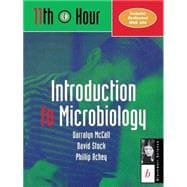
Darralyn McCall and David Stock are the authors of 11th Hour: Introduction to Microbiology, published by Wiley.
| 11th Hour Guide to Success | ix | ||||
| Preface | x | ||||
| Unit I: Structure, Physiology, and Control of Microorganisms | 1 | (110) | |||
|
3 | (10) | |||
|
3 | (2) | |||
|
5 | (2) | |||
|
7 | (6) | |||
|
13 | (11) | |||
|
13 | (2) | |||
|
15 | (3) | |||
|
18 | (6) | |||
|
24 | (13) | |||
|
24 | (4) | |||
|
28 | (3) | |||
|
31 | (6) | |||
|
37 | (14) | |||
|
37 | (3) | |||
|
40 | (3) | |||
|
43 | (8) | |||
|
51 | (11) | |||
|
51 | (3) | |||
|
54 | (2) | |||
|
56 | (6) | |||
|
62 | (15) | |||
|
62 | (3) | |||
|
65 | (3) | |||
|
68 | (3) | |||
|
71 | (6) | |||
|
77 | (11) | |||
|
77 | (2) | |||
|
79 | (2) | |||
|
81 | (1) | |||
|
82 | (6) | |||
|
88 | (11) | |||
|
88 | (1) | |||
|
89 | (3) | |||
|
92 | (1) | |||
|
93 | (6) | |||
|
99 | (12) | |||
|
99 | (3) | |||
|
102 | (2) | |||
|
104 | (2) | |||
|
106 | (5) | |||
| Unit II: Microbial Genetics | 111 | (42) | |||
|
113 | (17) | |||
|
113 | (5) | |||
|
118 | (3) | |||
|
121 | (2) | |||
|
123 | (7) | |||
|
130 | (23) | |||
|
130 | (3) | |||
|
133 | (1) | |||
|
134 | (2) | |||
|
136 | (2) | |||
|
138 | (15) | |||
|
146 | (7) | |||
| Unit III: Medical Microbiology, Immunology, Environmental and Applied Microbiology | 153 | (130) | |||
|
155 | (14) | |||
|
155 | (3) | |||
|
158 | (1) | |||
|
159 | (2) | |||
|
161 | (2) | |||
|
163 | (6) | |||
|
169 | (9) | |||
|
169 | (2) | |||
|
171 | (2) | |||
|
173 | (5) | |||
|
178 | (17) | |||
|
178 | (3) | |||
|
181 | (2) | |||
|
183 | (3) | |||
|
186 | (2) | |||
|
188 | (7) | |||
|
195 | (19) | |||
|
195 | (6) | |||
|
201 | (2) | |||
|
203 | (1) | |||
|
204 | (2) | |||
|
206 | (8) | |||
|
214 | (14) | |||
|
214 | (3) | |||
|
217 | (3) | |||
|
220 | (2) | |||
|
222 | (6) | |||
|
228 | (14) | |||
|
228 | (2) | |||
|
230 | (2) | |||
|
232 | (3) | |||
|
235 | (7) | |||
|
242 | (12) | |||
|
242 | (3) | |||
|
245 | (3) | |||
|
248 | (6) | |||
|
254 | (10) | |||
|
254 | (3) | |||
|
257 | (1) | |||
|
258 | (6) | |||
|
264 | (19) | |||
|
264 | (4) | |||
|
268 | (15) | |||
|
273 | (10) | |||
| Index | 283 |
The New copy of this book will include any supplemental materials advertised. Please check the title of the book to determine if it should include any access cards, study guides, lab manuals, CDs, etc.
The Used, Rental and eBook copies of this book are not guaranteed to include any supplemental materials. Typically, only the book itself is included. This is true even if the title states it includes any access cards, study guides, lab manuals, CDs, etc.